Disadvantages Of Data Science
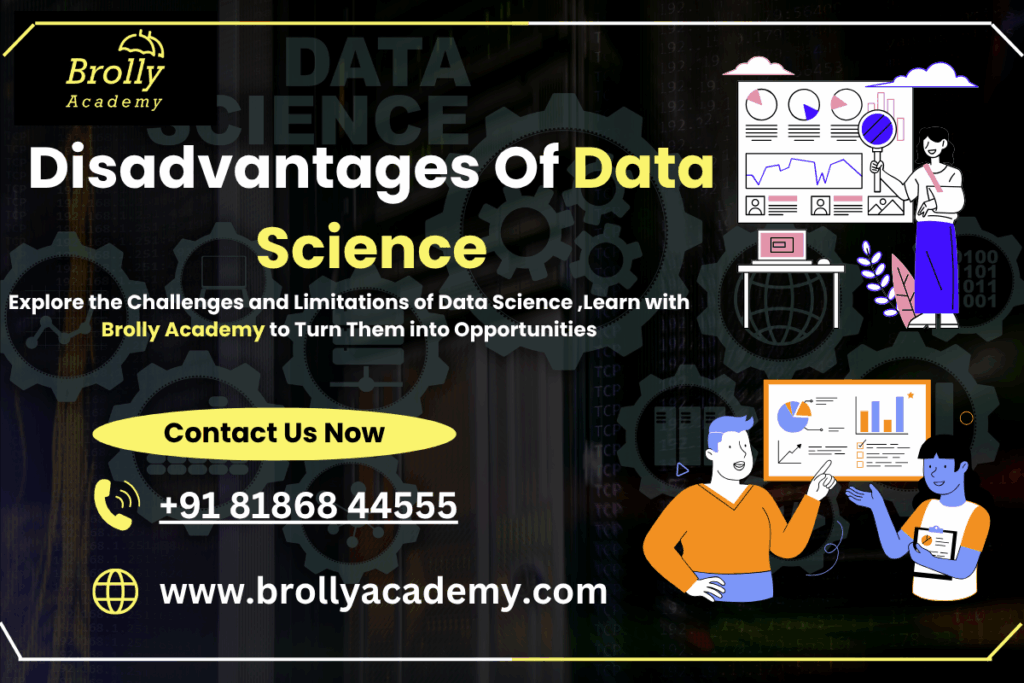
Table of Contents
ToggleOverview Of Disadvantages Of Data Science
Disadvantages Of Data Science
1. The Hidden Side of Data Science
- Data Science is transforming industries with automation, AI, and predictive analytics — but beneath its success lies a range of challenges.
- The field demands high computational resources, complex tools, and skilled professionals, making it difficult for many organizations to adopt effectively.This is major disadvantages of data Science.
2. High Cost and Resource Demands
- Building a data-driven system isn’t cheap. From data collection and storage to maintaining machine learning models and cloud infrastructure, the financial burden can be massive.
- These resource-intensive procedures are difficult for many small enterprises to handle, which results in waste and inefficiency.
3. Data Privacy and Ethical Concerns
- Concerns regarding prejudice, data privacy, and ethical ramifications have become inevitable due to our increasing reliance on big data and prediction algorithms.
- Organizations face significant legal and reputational concerns when personal data is misused or handled improperly.
4. Skill Gap and Complexity
- Data Science isn’t just about collecting data — it requires deep knowledge of statistics, programming, and machine learning.
- The skill gap in data science makes it hard for companies to find qualified experts, often slowing innovation and increasing project failures.
5. Inaccurate Insights and Data Bias
- Even powerful AI models can fail when the underlying data quality is poor or biasedInaccurate insights can result in bad business choices, inaccurate forecasts, and a decline in user confidence.
- The correctness and integrity of data are crucial to data science since even a single incorrect assumption can change entire results.
6. Time-Consuming and Complex Processes
- The data cleaning, modeling, and validation process often takes more time than expected.
- This makes data science projects resource-intensive and hard to scale without proper strategy and automation.
7. The Reality Check
- Despite its advantages, data science isn’t flawless. It has high operating costs, privacy violations, and misinterpretation hazards.
- Understanding these limitations of data science is essential before integrating it into business or career decisions.This is the overview of Disadvantages of Data Science.
What is Data Science?
- Data Science is the art and science of turning raw data into clear, actionable insights that drive better decisions.
- At its heart, data science combines statistics, programming, and domain knowledge to collect, clean, analyze, model, and communicate information from data.
Definition of Data Science and Its Core Components
Definition : Data Science is the process of extracting meaningful patterns and knowledge from data using mathematical models, algorithms, and visualization — then using those results to inform decisions.
- Data Collection & Ingestion: Gathering data from databases, APIs, sensors, logs, and third-party sources. Reliable answers start with good inputs.
- Data Cleaning & Preprocessing: Removing errors, filling gaps, standardizing formats, and transforming raw inputs into a usable dataset.
- Exploratory Data Analysis (EDA): Visualizing and summarizing data (charts, summary stats) to understand distributions, trends, and anomalies before building models.
- Feature Engineering: Creating or selecting the most informative signals (features) from raw data — the “secret sauce” that often determines model performance.
- Modeling & Machine Learning: Applying algorithms (regression, tree-based models, clustering, neural networks) to detect patterns, classify items, or predict future outcomes.
- Evaluation & Validation: Testing models with holdout data, cross-validation, and performance metrics (accuracy, precision, recall, RMSE) to ensure results are reliable.
- Deployment & Monitoring: Putting models into production (APIs, dashboards) and continuously monitoring them for drift, errors, and performance decay.
- Communication & Decision Support: Translating technical results into simple, actionable recommendations via dashboards, reports, or presentations so stakeholders can act.
H3: Relevance of Data Science Across Sectors (Business, Healthcare, Technology)
Data science isn’t academic theory — it’s everywhere. Here’s how it creates value in real industries, explained in a user-friendly way:
Business & Finance:
Use cases: customer segmentation, churn prediction, dynamic pricing, fraud detection.
Impact: helps companies increase revenue, cut costs, and personalize customer experience.
Example: An e-commerce firm uses predictive models to show products each user is most likely to buy — boosting conversions.
Healthcare & Life Sciences:
Use cases: disease prediction, personalized medicine, medical imaging analysis, drug discovery.
Impact: improves diagnosis speed/accuracy, optimizes treatment plans, and speeds research.
Example: Machine learning models analyze medical scans to detect early signs of disease that humans might miss.
Technology & Software:
Use cases: recommendation systems, search ranking, natural language processing (NLP), anomaly detection in systems.
Impact: enhances user experience, automates support, improves security monitoring.
Example: Streaming platforms recommend shows using collaborative filtering and content analysis to keep users engaged.
Manufacturing & IoT:
Use cases: predictive maintenance, supply chain optimization, quality control.
Impact: reduces downtime, improves yield, and lowers operational costs.
Example: Sensors on machines signal maintenance before a breakdown, saving expensive repairs.
Public Sector & Social Good:
Use cases: traffic optimization, resource allocation, epidemic modeling.
Impact: improves public services, targets interventions, and informs policy decisions.
Example: Health agencies model disease outbreaks to prioritize vaccine distribution.
H3: Tools and Techniques Used in Data Science (Brief but In-Depth)
Data science uses a rich ecosystem of tools and techniques. Below is a practical tour grouped by purpose — with one-line descriptions so readers grasp why each exists.
1.Programming & Notebooks
- Python / R: Primary languages for data analysis and modeling — Python for production-readiness, R for statistical exploration.
- Jupyter / RStudio: Interactive notebooks for exploration, documentation, and sharing reproducible work.
2.Data Storage & Processing
- SQL / NoSQL databases: Store and query structured (SQL) and unstructured (NoSQL) data.
- Big Data frameworks (Spark, Hadoop): Process very large datasets across clusters when single machines aren’t enough.
3.Machine Learning & Modeling
- Scikit-learn / Statsmodels: Libraries for classic ML algorithms and statistical modeling.
- TensorFlow / PyTorch: Deep learning frameworks for neural networks and advanced AI.
- AutoML tools: (e.g., H2O.ai, Google AutoML) Automate model selection and tuning to speed up development.
4.Data Engineering & Workflow
- ETL Tools (Airflow, Luigi): Schedule and orchestrate data pipelines — move data from raw sources to cleaned datasets.
- Docker / Kubernetes: Package and deploy models in consistent environments at scale.
5.Cloud & Infrastructure
- AWS / Azure / Google Cloud: Provide storage, managed ML services (SageMaker, Vertex AI), and scalable compute.
- Serverless / Lambda: Run small model inference jobs without managing servers.
6.Visualization & Reporting
- Tableau / Power BI / Plotly / Matplotlib: Create dashboards and visual stories that make data understandable to non-technical stakeholders.
7.Specialized Techniques (what they do)
- Supervised Learning: Predict labels (e.g., churn yes/no) from past examples.
- Unsupervised Learning: Find hidden structure (clustering, anomaly detection) without labelled outcomes.
- NLP (Natural Language Processing): Extract meaning from text (sentiment, summarization).
- Computer Vision: Interpret images and video (object detection, medical imaging).
- Time Series Analysis: Forecast future values (sales, sensor readings) using temporal models.
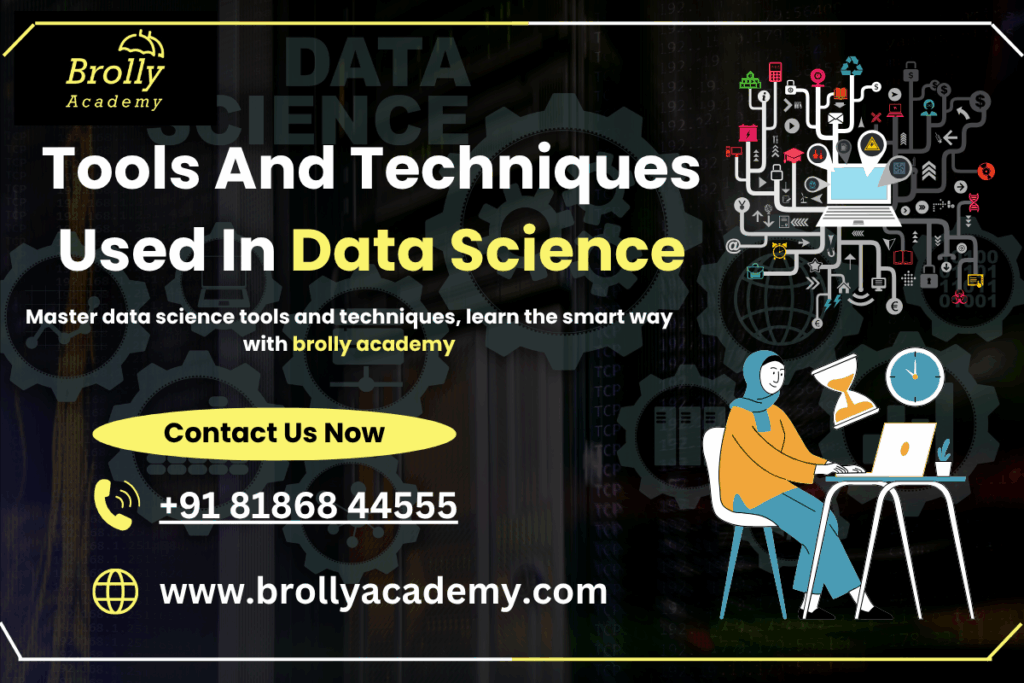
Why Is Data Science So Popular Today?
- In this Digital era, Data Science has become the backbone of intelligent decision-making and business growth.
- Every click, transaction, and online interaction generates data — and organizations are racing to turn that data into actionable insights.
- This surge in data-driven strategies has made data science professionals some of the most in-demand experts across industries.
Growing Demand Across Industries
From finance and healthcare to e-commerce, manufacturing, and technology, every sector now relies on data to drive smarter outcomes.
- Businesses use data science for , customer segmentation, and sales forecasting.
- Healthcare organizations apply it to predict diseases and improve patient care.
- Tech companies depend on machine learning algorithms for recommendations, personalization, and automation.
Applications That Drive Smarter Decisions
The popularity of data science stems from its power to simplify decision-making and enhance operational efficiency.
- Predictive analytics allows businesses to forecast trends and consumer behavior.
- Data visualization tools like Tableau and Power BI make complex data stories easy to understand.
Automation and machine learning models reduce manual errors, increase productivity, and deliver data-driven solutions faster
Why Everyone’s Talking About Data Science
- Data Science is not just a technology — it’s a strategic necessity.
- With the explosion of big data, cloud computing, and AI innovations, companies now understand that ignoring data means losing their competitive edge.
- It’s this potential to revolutionize decision-making, reduce costs, and personalize customer experiences that has made data science one of the most influential fields of the modern age.However, behind all this excitement lies a less-discussed side — the limitations, challenges, and disadvantages of data science that organizations often overlook. Let’s uncover those hidden truths in the next section.
Contextualizing the Popularity of Data Science
- The rapid rise of Data Science is no accident — it’s the result of an increasingly data-driven world where every industry depends on insights to stay competitive.
- Businesses today no longer rely on guesswork; instead, they use data analytics, machine learning, and predictive modeling to make faster, smarter decisions.
- From improving customer experiences to streamlining operational efficiency, data science has become the backbone of innovation.
- However, as organizations race to adopt these advanced technologies, many overlook the hidden challenges and limitations that come with managing massive data volumes, ensuring accuracy, and maintaining ethical standards.
- While its popularity continues to soar, it’s equally important to understand the disadvantages of data science — the costs, complexities, and risks that often lie beneath the surface of this revolutionary field.
Key Disadvantages of Data Science
- Although Data Science is shaping industries through innovation and intelligent automation, it’s essential to understand its limitations and practical challenges.
- Below are the most common disadvantages of Data Science that impact businesses, professionals, and real-world implementations.
1. High Cost of Implementation
One of the most significant limitations of data science is its high cost of setup and maintenance. Building a data-driven environment requires investment in data storage systems, cloud computing infrastructure, advanced tools, and highly skilled professionals.
- Small and medium businesses often find it difficult to afford such resources.
- Continuous upgrades, software licenses, and hardware scalability further increase expenses.
2. Data Privacy and Ethical Concerns
As big data continues to grow, data privacy has become a major issue in the digital world. Data science relies heavily on collecting and analyzing large volumes of personal information, which can lead to ethical challenges and security risks.
- Misuse of sensitive data can result in legal penalties and reputation loss.
- Bias in machine learning algorithms may lead to unfair or discriminatory outcomes.
3. Shortage of Skilled Professionals
Despite the popularity of this field, there’s a massive skill gap in data science. Organizations struggle to find experts who possess the right mix of programming, statistical analysis, and business acumen.
- Lack of experienced professionals often leads to project delays or poor-quality insights.
- Companies are forced to spend heavily on training and recruitment.
4. Data Quality and Bias Issues
Even the most advanced machine learning models are only as good as the data they are trained on. Poor-quality or biased datasets can lead to inaccurate predictions, misleading insights, and faulty decision-making.
- Data collected from unreliable sources can compromise model accuracy.
- Biased data can cause ethical and social issues, especially in sensitive domains like healthcare or recruitment.
5. Time-Consuming and Complex Process
Data Science involves multiple stages — data collection, data cleaning, model training, and evaluation — all of which are time-intensive.
- Each step requires specialized tools and manual effort.
- Managing massive datasets demands powerful hardware and scalable architecture.
6. Misinterpretation of Results
Not all stakeholders understand data analysis correctly. When insights are misinterpreted, it can lead to wrong decisions and business losses.
- Miscommunication between data scientists and business teams is common.
- Overreliance on models without human judgment increases risk.
7. Dependence on Large Volumes of Data
Data Science thrives on massive datasets — the more the data, the better the models. But not every organization has access to such vast, clean, and relevant data.
- Limited data can result in poor model accuracy.
- Data collection also raises legal and ethical issues in some regions.
8. Limited Generalization and Real-World Accuracy
Models trained on historical data often fail in real-world scenarios due to changing patterns or unseen data.
- Predictive models may overfit or underperform when applied to new situations.
- Businesses that rely solely on data science without human insight risk inaccurate strategies.
9. Ethical and Legal Implications
Beyond privacy, ethical concerns in AI and data science continue to grow. Algorithms can unintentionally discriminate or be used in unethical ways if not properly monitored.
- Regulations like GDPR and HIPAA now require strict data handling policies.
- Companies face fines and legal risks for non-compliance.
10. Job Saturation and Career Uncertainty
Ironically, the booming popularity of data science careers has also led to rising competition and job saturation in certain markets.
- Entry-level positions are becoming harder to secure without advanced experience.
- Rapid evolution of tools means professionals must constantly upgrade their skills.
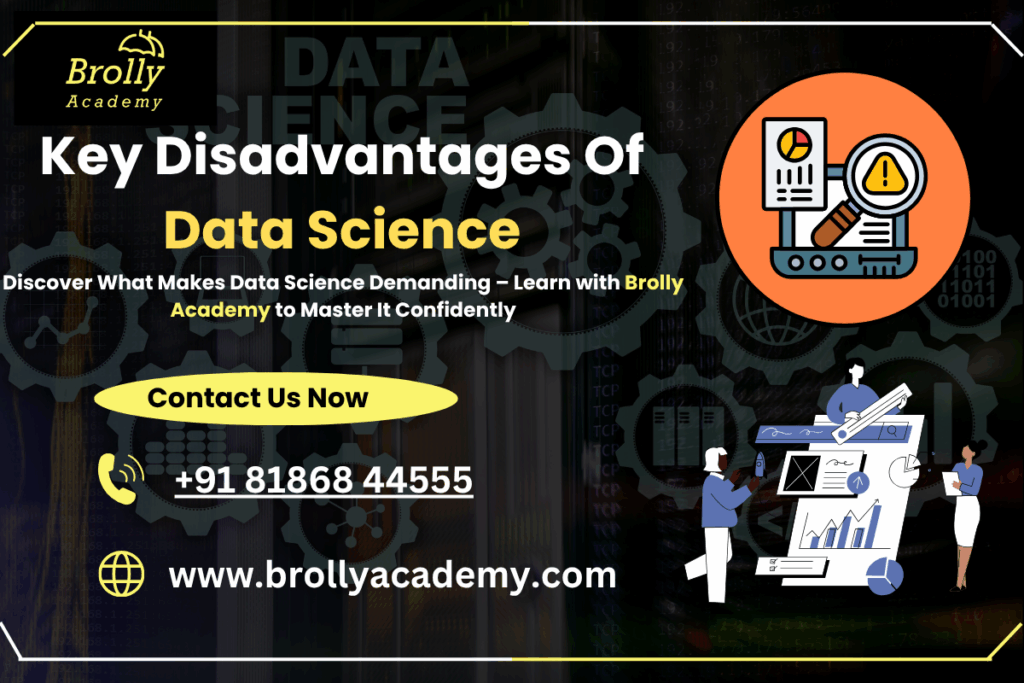
Challenges Faced by Organizations in Data Science Adoption
- Adopting Data Science in an organization isn’t as simple as implementing software or hiring a few data analysts — it involves a complete transformation of operations, strategy, and culture.
- Many companies, despite understanding the potential of data science, struggle to successfully integrate it into their business models.
- Below are the key operational, ethical, and financial challenges organizations commonly face in their data science adoption journey.
1. Operational Challenges and Integration Barriers
Integrating data-driven systems with existing business workflows often proves to be a major hurdle. Legacy systems may not support real-time data processing, and poor collaboration between IT, analytics, and business teams further delays results.
- Many organizations face issues in data collection, standardization, and storage.
- Lack of a data-first culture slows down adoption and decision-making.
2. High Financial Investment and ROI Uncertainty
Building a strong data science ecosystem demands huge financial investments in data infrastructure, cloud platforms, AI tools, and expert manpower. However, not every project guarantees measurable returns.
- Many companies struggle to quantify ROI from analytics projects.
- Budget constraints often prevent smaller businesses from fully leveraging advanced tools.
3. Skill Gap and Workforce Limitations
The shortage of skilled data scientists continues to be one of the most persistent challenges. Successful implementation requires experts in machine learning, data engineering, statistics, and business strategy — a rare combination to find in one team.
- Upskilling existing employees can be expensive and time-consuming.
Dependence on third-party vendors increases project costs and data security risks.
4. Data Management and Quality Control Issues
For data science to deliver accurate insights, organizations must manage data effectively — yet many fail to maintain data consistency, accuracy, and accessibility.
- Duplicate or unclean data leads to misleading analysis.
- Poor data governance practices affect model performance and reliability.
5. Time and Resource Constraints
Implementing data science initiatives involves a lengthy process of data preparation, model training, and testing, which consumes time and resources.
- Teams often underestimate the effort required for data preprocessing and model tuning.
Constant monitoring and maintenance make it a continuous, resource-heavy task.
6. Resistance to Change and Lack of Vision
A major non-technical challenge is organizational resistance. Employees and management may hesitate to trust AI-based decisions or adapt to new data-driven workflows.
- Lack of leadership vision often leads to incomplete or failed data projects.
- Internal resistance prevents data democratization across departments.
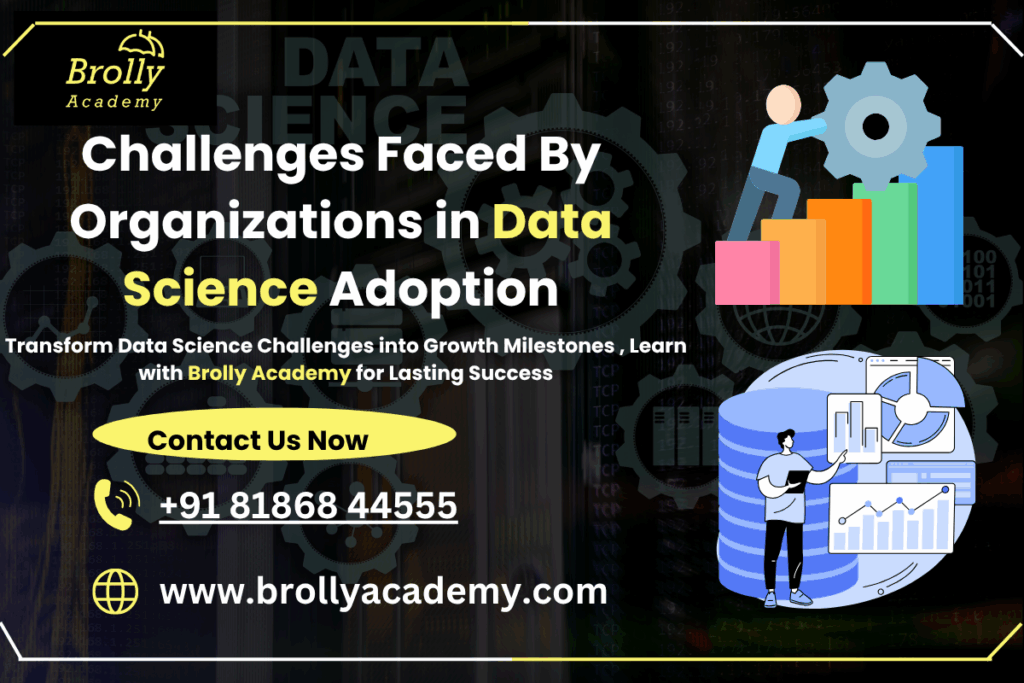
Ethical and Legal Implications of Data Science
- The rise of big data analytics and artificial intelligence has brought tremendous opportunities — but also serious ethical and legal responsibilities.
- Every organization handling user data must ensure transparency, fairness, and compliance to maintain public trust and follow data protection laws.
1. Data Privacy and Compliance Regulations
With the introduction of strict global data protection regulations such as GDPR (General Data Protection Regulation) in Europe and CCPA (California Consumer Privacy Act) in the U.S., companies must collect and process data responsibly.
- Non-compliance can result in hefty fines and legal consequences.
- Organizations must obtain explicit user consent before using personal data for analysis or AI models.
2. AI Bias and Ethical Accountability
Bias in machine learning algorithms is a growing ethical concern in data science. Models trained on biased or unbalanced datasets can lead to unfair, discriminatory outcomes — especially in sensitive areas like hiring, healthcare, or credit scoring.
- Ethical AI frameworks are essential to ensure fairness and transparency.
- Regular auditing and human oversight are needed to minimize bias.
3. Risk of Data Misuse and Surveillance
Organizations must guard against the misuse of personal data for profit-driven or manipulative purposes. Excessive data collection and behavioral tracking can lead to digital surveillance, eroding public trust.
- Data leaks and unauthorized access can severely damage a company’s reputation.
- Ethical boundaries must be clearly defined when dealing with personal information.
4. Transparency and Explainability in AI Models
Many AI models operate as “black boxes”, producing predictions without explaining how results are derived. This lack of transparency makes it difficult for users to trust or verify outcomes.
- Explainable AI (XAI) helps bridge this trust gap.
- Regulations are beginning to demand accountability for algorithmic decisions.
5. Global and Cross-Border Legal Challenges
Data often moves across borders — between cloud servers, data centers, and international teams. However, each region has its own data protection laws, creating compliance complexity for global organizations.
- Data localization laws may restrict where and how data is stored.
- Cross-border data transfers require proper encryption and regulatory approvals
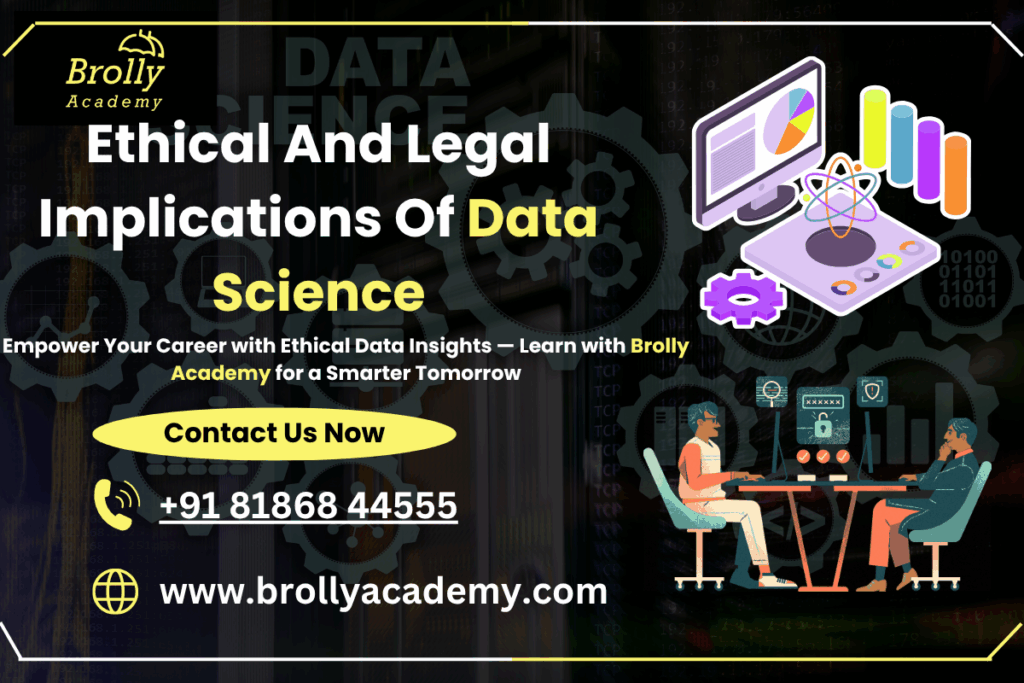
Conclusion
Building Ethical and Responsible Data Systems
- To fully harness the benefits of data science, organizations must balance innovation with responsibility.
- Following ethical principles, ensuring legal compliance, and maintaining data transparency not only protect user privacy but also build trust and credibility.
- Ethical data science isn’t just a regulatory requirement — it’s the foundation for sustainable digital growth.
FAQs
1. What are the main disadvantages of data science?
The major disadvantages of data science include high implementation cost, data privacy concerns, biased data, and a shortage of skilled professionals. These challenges make it difficult for organizations to fully utilize data-driven insights.
2. Why is data science considered expensive?
Data science is costly because it requires advanced infrastructure, cloud computing tools, and expert professionals. The cost of data storage, maintenance, and model development adds to the overall investment.
3. How does data privacy affect data science?
Data privacy impacts data science by limiting access to sensitive user information. Mishandling or unauthorized use of data can lead to legal penalties and loss of user trust.
4. What are the ethical issues in data science?
Ethical issues in data science include AI bias, unfair algorithms, and data misuse. Organizations must ensure ethical AI practices and compliance with laws like GDPR and CCPA.
5. Why is biased data a problem in data science?
Biased data can result in inaccurate predictions and unfair decisions. Machine learning models trained on unbalanced datasets may unintentionally discriminate against certain groups.
6. What are the challenges faced by organizations in data science adoption?
Organizations face operational, ethical, and financial challenges such as skill gaps, high costs, poor data quality, and complex integration with existing systems.
7. How does poor data quality affect decision-making?
Poor-quality data leads to incorrect insights and faulty predictions, which can negatively impact business decisions and overall performance.
8. Why is there a skill gap in data science?
The skill gap exists because data science requires expertise in machine learning, statistics, and business strategy, which few professionals master simultaneously.
9. What are the limitations of predictive analytics?
Predictive models often fail to adapt to real-world changes, leading to inaccurate outcomes. They depend on historical data, which might not reflect current patterns.
10. How do ethical regulations like GDPR impact data science?
Regulations like GDPR enforce data protection and transparency, requiring companies to handle personal data responsibly and avoid misuse or unauthorized access.
11. Is data science time-consuming?
Yes, data science projects involve lengthy processes such as data cleaning, model training, and evaluation, making them resource-intensive and time-consuming.
12. Why is data science difficult to implement in real-world scenarios?
Real-world data science implementation faces obstacles like data inconsistency, technical complexity, and organizational resistance to change.
13. What are the financial challenges in adopting data science?
The biggest financial challenges include high infrastructure cost, software licensing, and continuous system upgrades needed to maintain scalability.
14. How can data science lead to wrong decisions?
When data insights are misinterpreted or analyzed without context, it can result in misguided strategies and business losses.
15. What is the dependency of data science on large datasets?
Data science relies on massive datasets for accurate model training. Without sufficient or relevant data, models produce weak and unreliable outcomes.
16. Can small businesses afford data science implementation?
Most small and medium enterprises (SMEs) struggle with the high cost of data infrastructure, making full-scale data science adoption challenging.
17. What are the ethical implications of AI in data science?
AI in data science can raise ethical implications like bias, lack of transparency, and privacy risks, making responsible AI governance crucial.
18. How can organizations overcome data bias issues?
By maintaining balanced datasets, performing bias audits, and ensuring human oversight, organizations can reduce data bias in models.
19. What are the risks of data misuse in organizations?
Data misuse can result in privacy breaches, legal actions, and brand reputation damage. Proper governance policies are essential to prevent misuse.
20. How does data science affect job security?
With the automation of analytics, some traditional roles may decline, while rapid tool evolution requires professionals to constantly upskill to stay relevant.
21. Is the data science job market becoming saturated?
Yes, the job market is becoming highly competitive, especially for entry-level professionals, due to a surge in graduates entering the field.
22. What are common data governance challenges?
Common data governance issues include lack of standardization, data duplication, and inconsistent security protocols across departments.
23. How does AI bias occur in data science?
AI bias occurs when training datasets reflect human or historical bias, leading to unfair algorithmic predictions.
24. Why is data interpretation important in data science?
Proper data interpretation ensures that insights are understood in the right context, preventing misguided business decisions and data miscommunication.
25. What role does data quality play in model performance?
Data quality directly affects model accuracy — clean, consistent data produces reliable predictions, while poor data reduces model performance.
26. How can organizations ensure ethical data usage?
Organizations should follow ethical frameworks, enforce data privacy policies, and maintain transparency in how user data is collected and analyzed.
27. What are the limitations of machine learning models in data science?
Machine learning models can overfit, misinterpret data, or fail under new conditions, limiting their real-world accuracy.
28. Why do many data science projects fail?
Many projects fail due to lack of clear objectives, insufficient data quality, poor collaboration, or unrealistic expectations about outcomes.
29. How do global laws affect data science adoption?
Different countries have unique data protection laws, making cross-border data transfers and compliance difficult for global organizations.
30. What steps can companies take to handle data science challenges effectively?
Companies can overcome challenges by investing in skilled talent, ensuring ethical data practices, improving data governance, and using scalable infrastructure.

